Nanomaterials Market Size
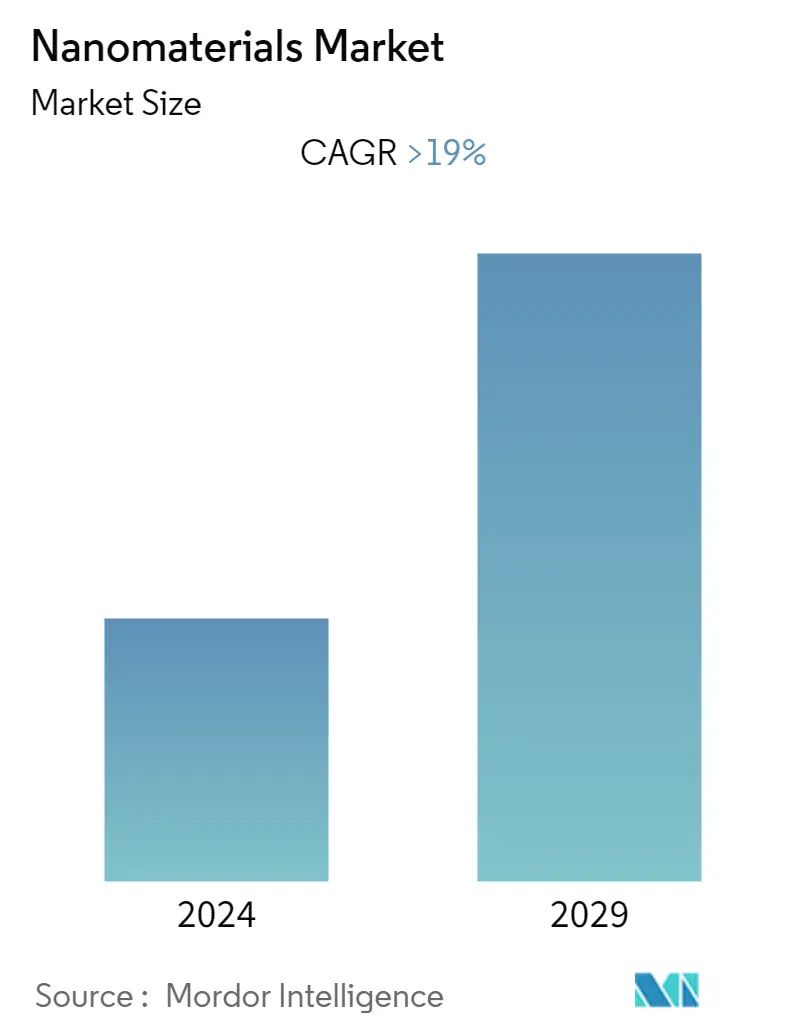
| Study Period | 2019 - 2029 |
| Base Year For Estimation | 2023 |
| CAGR | > 19.00 % |
| Fastest Growing Market | Asia Pacific |
| Largest Market | Asia-Pacific |
| Market Concentration | Low |
Major Players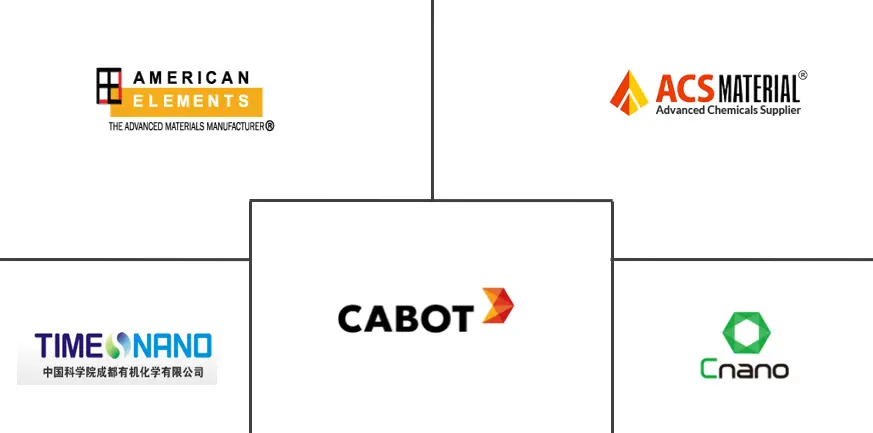
*Disclaimer: Major Players sorted in no particular order |
Need a report that reflects how COVID-19 has impacted this market and its growth?
Nanomaterials Market Analysis
The nanomaterials market is expected to register a CAGR of more than 19 % during the forecast period.
Due to the COVID-19 pandemic, various countries worldwide imposed lockdowns in the first nine months of 2020. Thus, various manufacturing plants and production facilities were shut down or halted production. This situation negatively affected the demand for construction, electronics, rubber, and personal care applications. However, increased usage of nanomaterials in healthcare and construction industries helped the market to retain its growth rate in 2021.
- The growing usage of nanomaterials in the healthcare industry and the increasing usage of nanomaterials in water treatment applications are expected to drive the demand in the nanomaterials market during the forecast period.
- However, higher technology costs are expected to hinder the market's growth.
- Increasing research activities and growing applications of nanomaterials is expected to act as market opportunity in the forecast period.
- The Asia-Pacific is expected to drive the market growth rate during the forecast period.
Nanomaterials Market Trends
This section covers the major market trends shaping the Nanomaterials Market according to our research experts:
The Electrical and Electronics Segment to Dominate the Market
- In the electrical and electronics segment, the demand for nanomaterials has been greatly increasing owing to major advances in computing and electronics, leading to faster, smaller, and more portable systems that can manage and store progressively larger amounts of information.
- Some of the major applications of nanomaterials in the electronics industry include the use of carbon nanotubes in semiconductor chips, the use of a variety of nanomaterials in lighting technologies, including light-emitting diodes or LEDs and organic light-emitting diodes or OLEDs, use of quantum dots in lasers, along with ongoing research into the application of others.
- The electronics manufacturing market in Asia-Pacific is expected to grow rapidly during the upcoming years due to the presence of a large number of original equipment manufacturers (OEMs) in the region. Low cost, the availability of raw materials, and cheap labor are driving the growth of the sector. The companies in the region provide manufacturing and assembling services to companies in Germany, France, and the United States.
- China has the world's largest electronics production base and offers tough competition to the existing upstream producers, such as South Korea, Singapore, and Taiwan. Electronic products, such as smartphones, OLED TVs, and tablets, among others, registered the highest growth in the consumer electronics segment of the market in terms of demand.
- As per a report published by JEITA, the production of global electronics and IT industries is expected to increase significantly in 2023 and reach USD 3,526.6 million compared to USD 3,415.9 billion in 2021.
- In Ho Chi Minh City, Vietnam, the South Korean giant, Samsung has heavily invested in a production facility, along with many other multinational electronic firms, like Japan's Sharp and Denmark's Sonion. Microsoft, Nintendo, Ricoh, and Dell, are some other companies that plan to set up production lines in Vietnam.
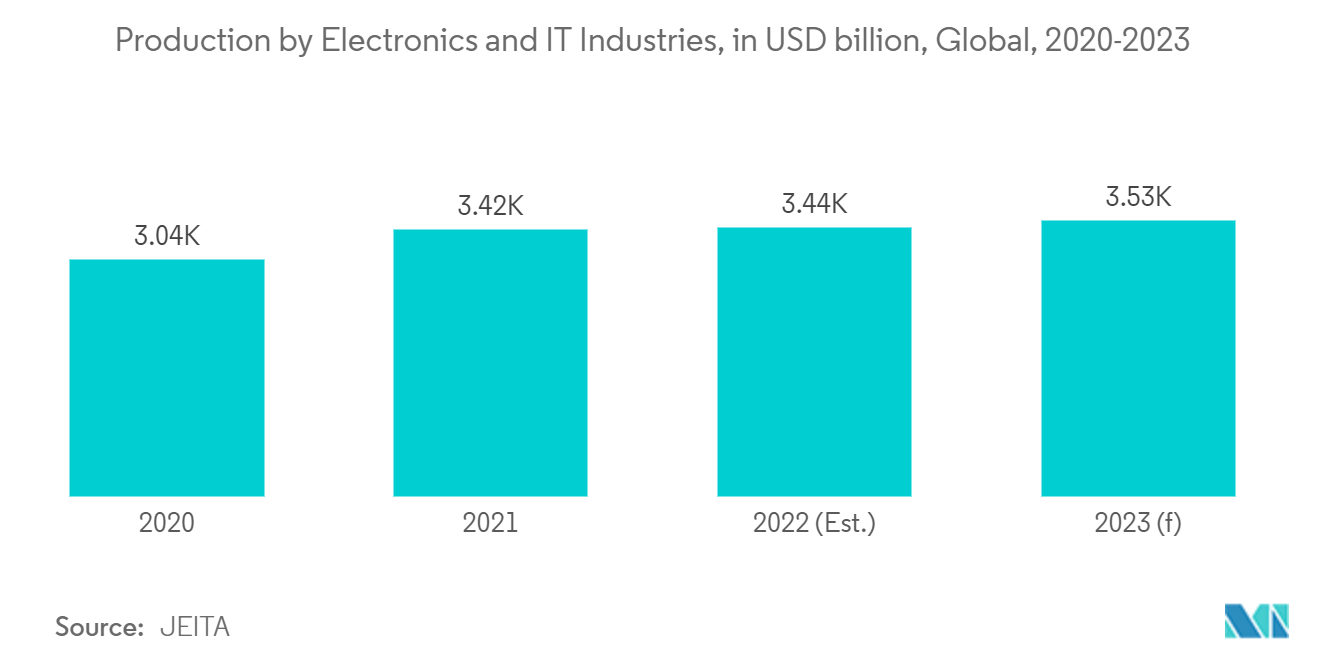
Asia Pacific Region to Dominate the Nanomaterials Market
- The Asia-Pacific region dominates the global market share. With growing construction activities and the increasing demand for furniture in countries such as China, India, and Japan, the demand for nanomaterials is increasing in the region.
- The Chinese government has policies to support and encourage domestic medical device innovation, providing opportunities for the market studied. As the second-largest healthcare industry globally, behind the United States, the country's healthcare market has been more rigorous, especially in light of the COVID-19 pandemic in 2020. China is expected to have 25% of the global medical device industry revenue share by 2030.
- The healthcare sector in India was expected to reach USD 372 billion by 2022, mainly driven by increasing health awareness, access to insurance, rising income, and diseases. The medical sector in India is benefiting from the growing population at a rate of 1.6% per year. An aging population of over 100 million, rising incidences of lifestyle diseases, rising incomes, and increased penetration of health insurance are fueling the growth of more sophisticated and accurate medical devices in the industry.
- In Japan, the 65-and-above demographic represents around 30% of the country's total population and is expected to reach around 40% by 2050. The rapidly aging Japanese population, the increasing number of patients with chronic and lifestyle diseases, and universal health insurance coverage and regulatory measures are driving the Japanese healthcare market. Japan is boosting its medical sector as its citizens are getting older at a faster rate than the citizens of any other nation.
- Thailand is acclaimed as a major healthcare hub in Asia. Thailand, as a leader in Asia, is found to be playing a vital role in many regional and international organizations, dedicated to promoting the advancement of medical devices in the area. Most of the medical devices manufactured in Thailand for export fall into the category of single-use devices and approximately 84% of the revenue of all medical supplies exported are in this group.
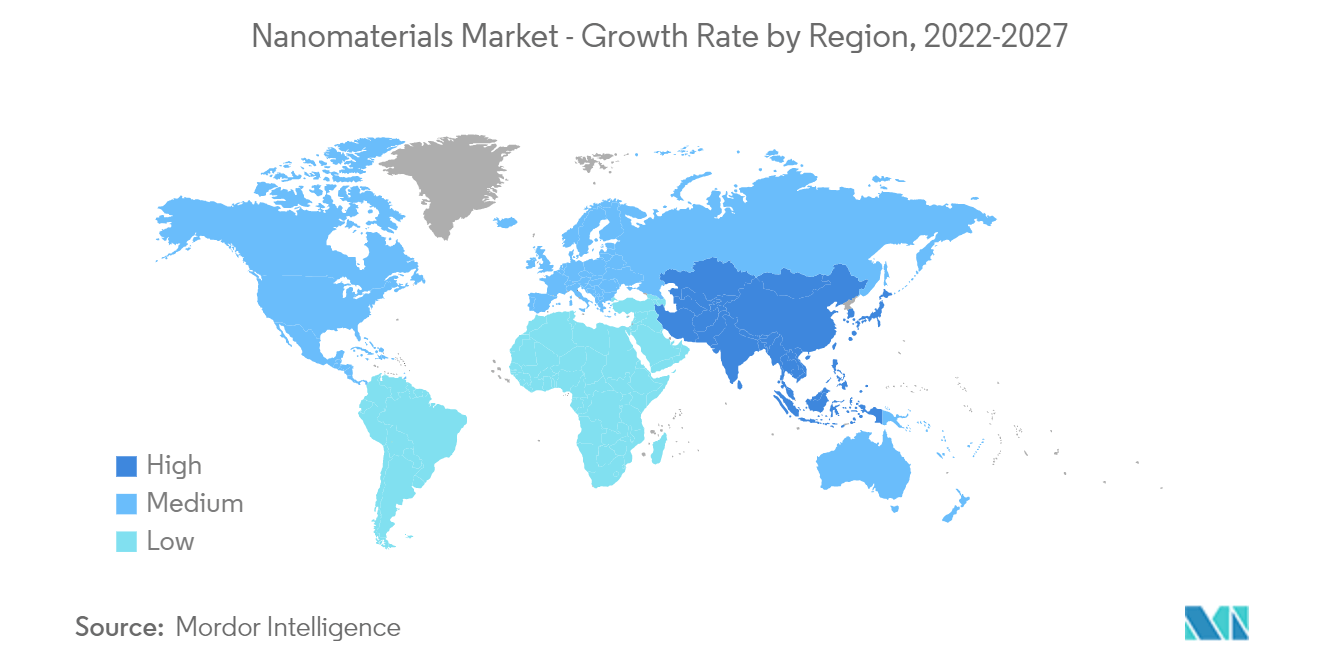
Nanomaterials Industry Overview
The nanomaterials market is highly fragmented. The companies in the market focus on specific types of nanomaterials and also on specific applications. Some of the key players in the market (in no particular order) include American Elements, Chengdu Organic Chemicals Co. Ltd (Timesnano), Jiangsu Cnano Technology Co. Ltd, Cabot Corporation, and ACS Material, among others.
Nanomaterials Market Leaders
American Elements
Chengdu Organic Chemicals Co. Ltd (Timesnano)
Jiangsu Cnano Technology Co. Ltd
Cabot Corporation
ACS Material
*Disclaimer: Major Players sorted in no particular order
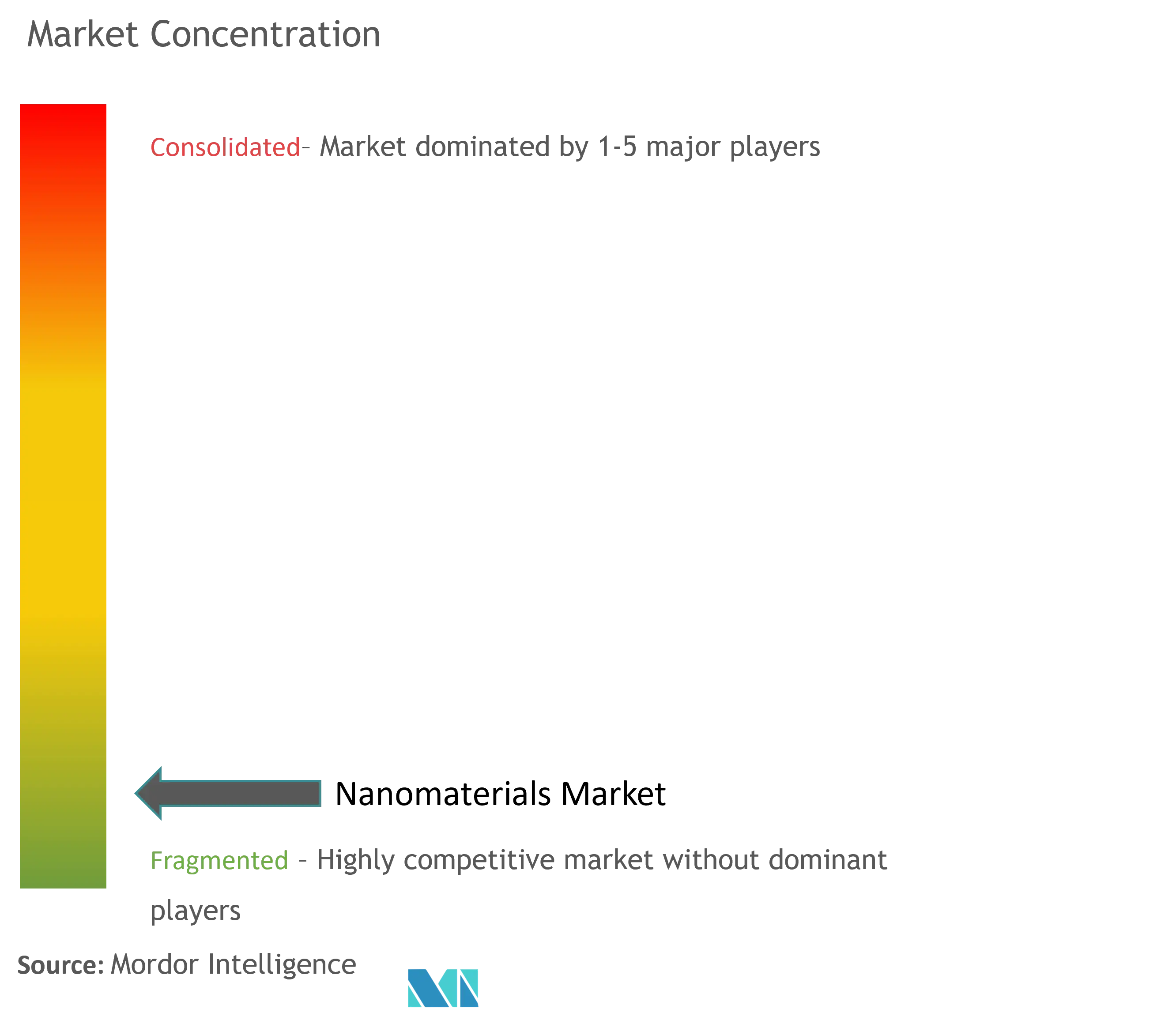
Nanomaterials Market News
- In November 2022, American Elements launched a novel nanoscale electrolyte material that will be used in lithium-ion batteries. The electrolyte is an energy-dense and ceramic compound of lithium, lanthanum, and zirconium oxide nanoparticles.
- In March 2021, Cabot Corporation announced the launch of a new ENERMAX 6 carbon nanotube (CNT) series. ENERMAX 6 carbon nanotube products are the company's latest development in high-performance CNTs. It is proven to be the most conductive multi-walled CNT product in Cabot's portfolio.
Nanomaterials Market Report - Table of Contents
1. INTRODUCTION
1.1 Study Assumptions
1.2 Scope of the Study
2. RESEARCH METHODOLOGY
3. EXECUTIVE SUMMARY
4. MARKET DYNAMICS
4.1 Drivers
4.1.1 Growing Usage of Nanomedicines in the Healthcare Industry
4.1.2 Increasing Usage of Nanomaterials in Water Treatment Applications
4.2 Restraints
4.2.1 Higher Costs of Technology
4.3 Industry Value Chain Analysis
4.4 Porter's Five Forces Analysis
4.4.1 Bargaining Power of Suppliers
4.4.2 Bargaining Power of Consumers
4.4.3 Threat of New Entrants
4.4.4 Threat of Substitute Products and Services
4.4.5 Degree of Competition
5. MARKET SEGMENTATION (Market Size in Value)
5.1 Product Type
5.1.1 Nanoparticles
5.1.1.1 Nanometals
5.1.1.1.1 Gold
5.1.1.1.2 Silver
5.1.1.1.3 Platinum
5.1.1.1.4 Titanium
5.1.1.1.5 Aluminium
5.1.1.2 Nonmetal Oxides
5.1.1.2.1 Alumina
5.1.1.2.2 Iron Oxide
5.1.1.2.3 Titanium Oxide
5.1.1.2.4 Silica
5.1.1.2.5 Zinc Oxide
5.1.1.3 Complex Oxides
5.1.1.3.1 Calcium Phosphate
5.1.1.3.2 Rare Earth Metal Oxides
5.1.1.3.3 Lithium Titanate
5.1.1.3.4 Silica Hydride
5.1.2 Nanofibers
5.1.3 Nanotubes
5.1.4 Nanoclays
5.1.5 Nanowires
5.2 Structure Type
5.2.1 Non-polymer Organic Nanomaterials
5.2.1.1 Carbon Black
5.2.1.2 Carbon Nanotubes
5.2.1.3 Aptamers
5.2.1.4 Small Molecule OLED
5.2.1.5 Activated Carbon
5.2.1.6 Carbon Nanotubes Composites
5.2.2 Polymeric Nanomaterials
5.2.2.1 Coatings and Adhesives
5.2.2.2 Transfection Reagents
5.2.2.3 Diagnostics Reagents
5.2.2.4 Drug Delivery Vehicle
5.2.2.5 Fabric Treatments
5.2.2.6 Optical Coatings
5.2.2.7 Nano-porous Filtration Membrane
5.2.2.8 Di-electric Films
5.2.2.9 OLED Films
5.3 End-user Industry
5.3.1 Construction
5.3.2 Electronics
5.3.3 Energy
5.3.4 Healthcare
5.3.5 Personal Care
5.3.6 Rubber
5.3.7 Other End-user Industries
5.4 Geography
5.4.1 Asia-Pacific
5.4.1.1 China
5.4.1.2 India
5.4.1.3 Japan
5.4.1.4 South Korea
5.4.1.5 ASEAN Countries
5.4.1.6 Rest of Asia-Pacific
5.4.2 North America
5.4.2.1 United States
5.4.2.2 Canada
5.4.2.3 Mexico
5.4.3 Europe
5.4.3.1 Germany
5.4.3.2 United Kingdom
5.4.3.3 Italy
5.4.3.4 France
5.4.3.5 Rest of Europe
5.4.4 South America
5.4.4.1 Brazil
5.4.4.2 Argentina
5.4.4.3 Rest of South America
5.4.5 Middle-East and Africa
5.4.5.1 Saudi Arabia
5.4.5.2 South Africa
5.4.5.3 Rest of Middle-East and Africa
6. COMPETITIVE LANDSCAPE
6.1 Mergers and Acquisitions, Joint Ventures, Collaborations, and Agreements
6.2 Market Share (%)**/Ranking Analysis
6.3 Strategies Adopted by Leading Players
6.4 Company Profiles
6.4.1 ACS Material
6.4.2 American Elements
6.4.3 Arkema Group
6.4.4 BASF SE
6.4.5 Cabot Corporation
6.4.6 CHASM Advanced Materials Inc.
6.4.7 Chengdu Organic Chemicals Co. Ltd (Timesnano)
6.4.8 Jiangsu Cnano Technology Co. Ltd
6.4.9 LG Chem
6.4.10 Nano-C
6.4.11 Nanocyl SA
6.4.12 Nanophase Technologies Corporation
6.4.13 OCSiAl
6.4.14 Raymor Industries Inc.
6.4.15 SHOWA DENKO K.K.
6.4.16 ZYVEX TECHNOLOGIES
- *List Not Exhaustive
7. MARKET OPPORTUNITIES AND FUTURE TRENDS
7.1 Increasing Research Activities and Growing Applications
Nanomaterials Industry Segmentation
Nanomaterials can be defined as materials possessing, at minimum, one external dimension measuring 1-100 nm. Nanomaterials can occur naturally, be created as the by-products of combustion reactions, or be produced purposefully through engineering to perform a specialized function. These materials can have different physical and chemical properties from their bulk-form counterparts.
The nanomaterials market is segmented by product type, structure type, end-user industry, and geography. By product type, the market is segmented into nanoparticles, nanofibers, nanotubes, nanoclays, and nanowires. By structure type, the market is segmented into non-polymer organic nanomaterials and polymeric nanomaterials. On the basis of the end-user industry, the market is segmented into healthcare, electrical and electronics, energy, construction, personal care, and other end-user industries. The report also covers the market size and forecasts for the market in 15 countries across major regions. For each segment, the market sizing and forecasts have been done on the basis of revenue (USD million).
| Product Type | ||||||||||||||||||||||
| ||||||||||||||||||||||
| Nanofibers | ||||||||||||||||||||||
| Nanotubes | ||||||||||||||||||||||
| Nanoclays | ||||||||||||||||||||||
| Nanowires |
| Structure Type | |||||||||||
| |||||||||||
|
| End-user Industry | |
| Construction | |
| Electronics | |
| Energy | |
| Healthcare | |
| Personal Care | |
| Rubber | |
| Other End-user Industries |
| Geography | ||||||||
| ||||||||
| ||||||||
| ||||||||
| ||||||||
|
Nanomaterials Market Research FAQs
What is the current Nanomaterials Market size?
The Nanomaterials Market is projected to register a CAGR of greater than 19% during the forecast period (2024-2029)
Who are the key players in Nanomaterials Market?
American Elements, Chengdu Organic Chemicals Co. Ltd (Timesnano), Jiangsu Cnano Technology Co. Ltd , Cabot Corporation and ACS Material are the major companies operating in the Nanomaterials Market.
Which is the fastest growing region in Nanomaterials Market?
Asia Pacific is estimated to grow at the highest CAGR over the forecast period (2024-2029).
Which region has the biggest share in Nanomaterials Market?
In 2024, the Asia-Pacific accounts for the largest market share in Nanomaterials Market.
What years does this Nanomaterials Market cover?
The report covers the Nanomaterials Market historical market size for years: 2019, 2020, 2021, 2022 and 2023. The report also forecasts the Nanomaterials Market size for years: 2024, 2025, 2026, 2027, 2028 and 2029.
Nanomaterials Industry Report
Statistics for the 2024 Nanomaterials market share, size and revenue growth rate, created by Mordor Intelligence™ Industry Reports. Nanomaterials analysis includes a market forecast outlook to 2029 and historical overview. Get a sample of this industry analysis as a free report PDF download.
